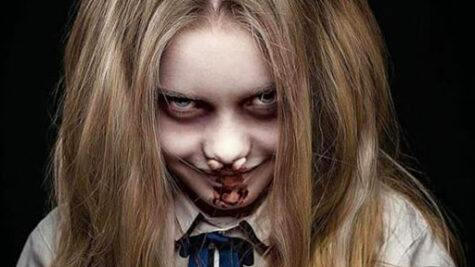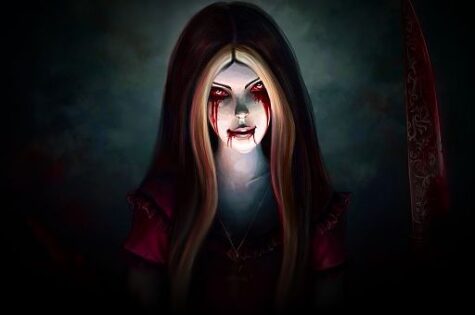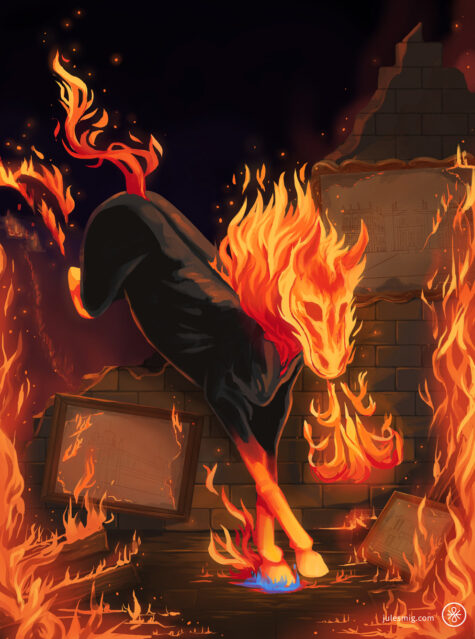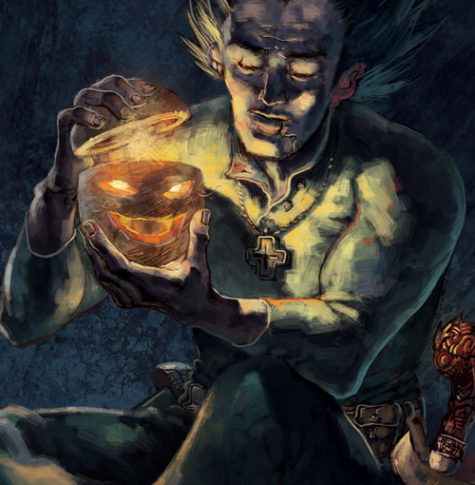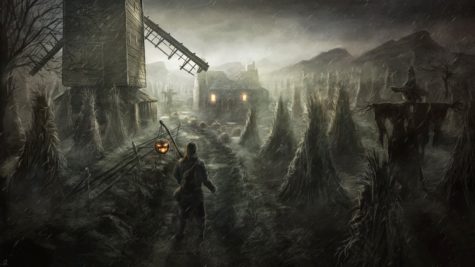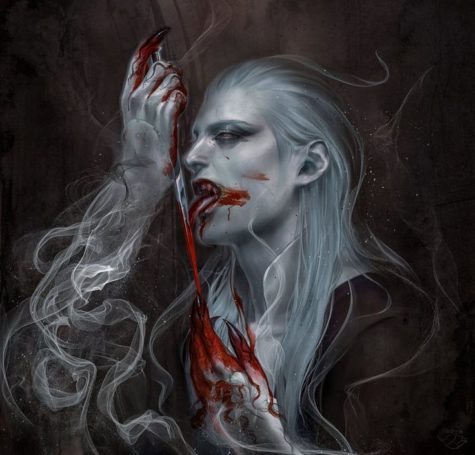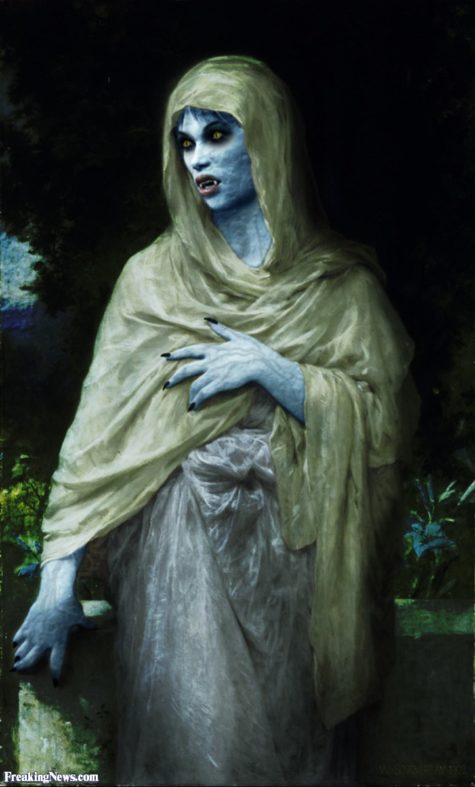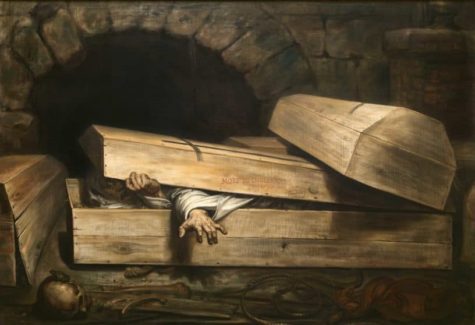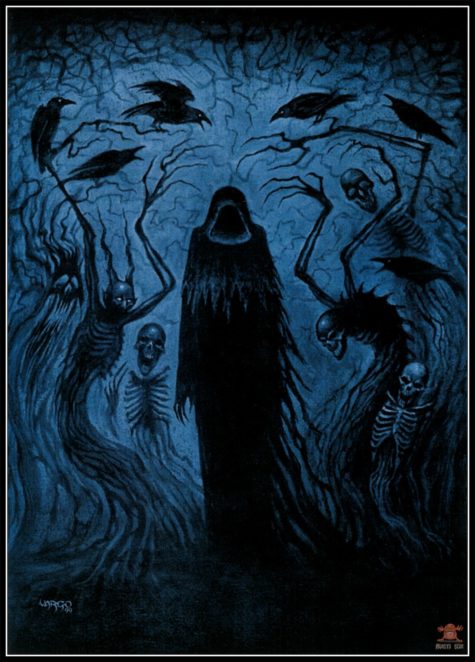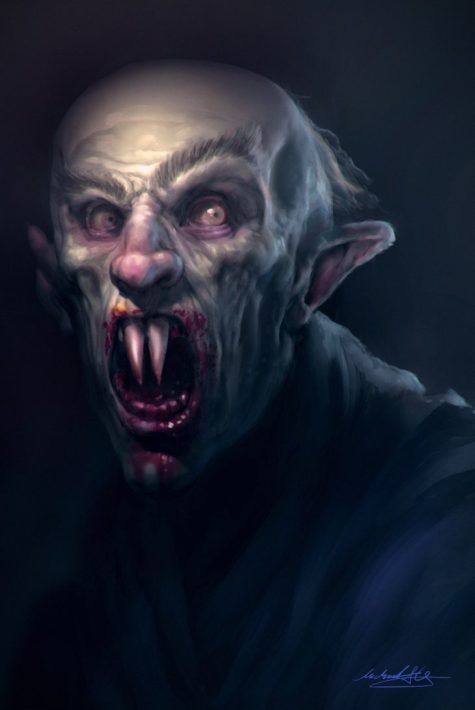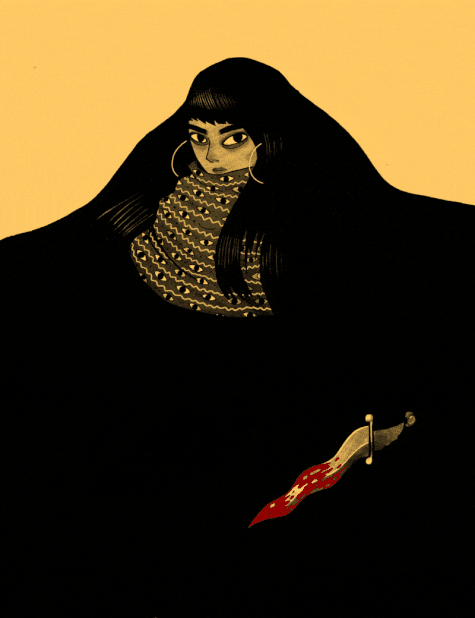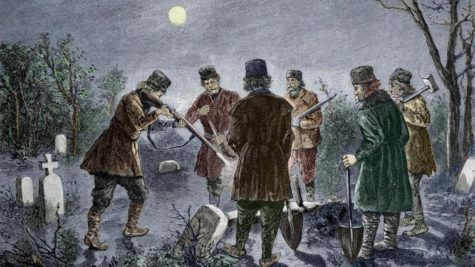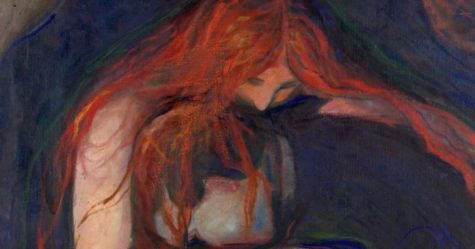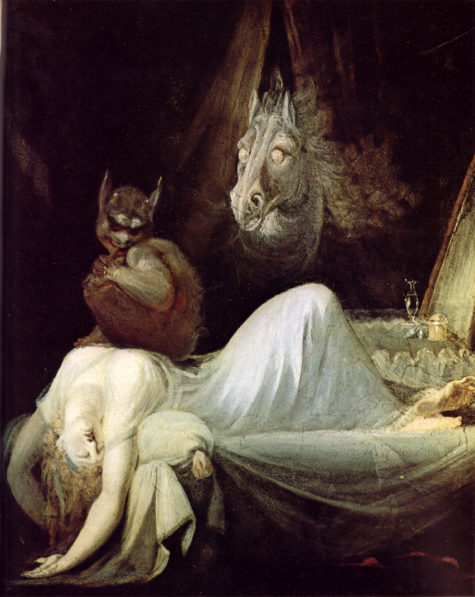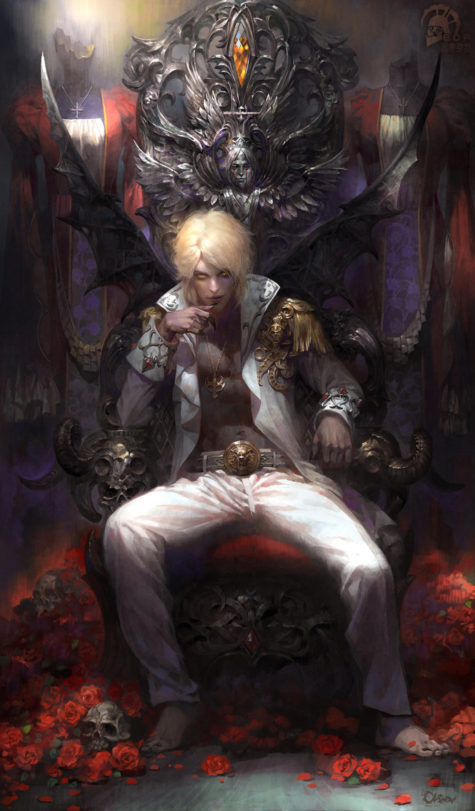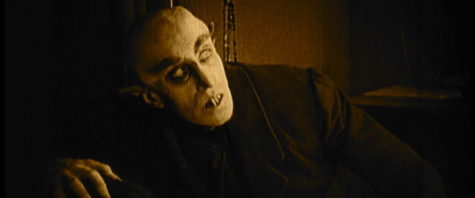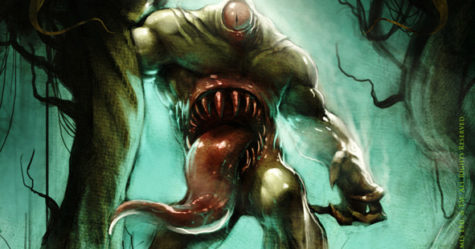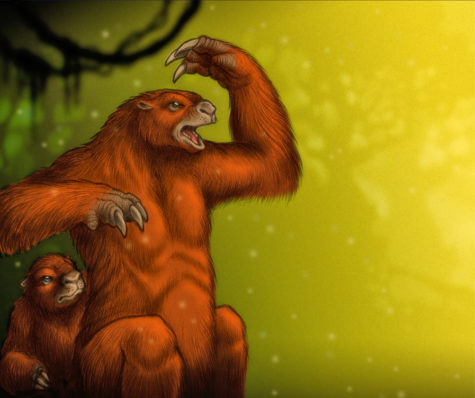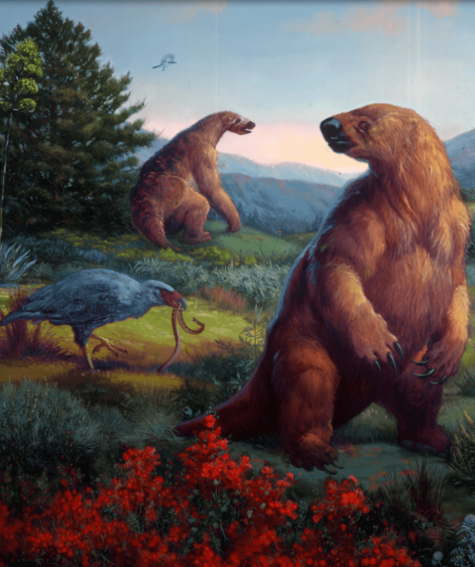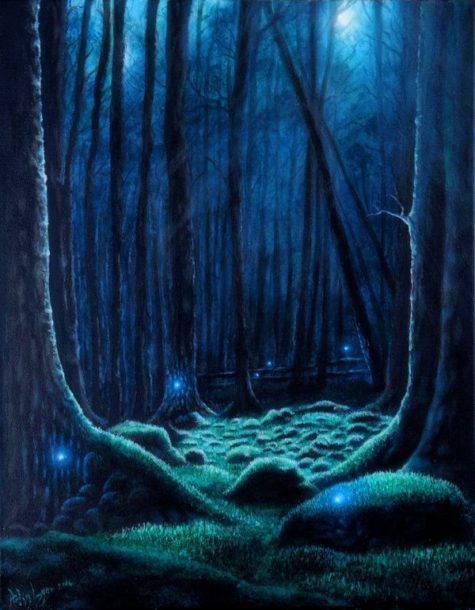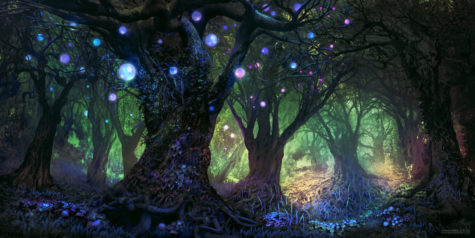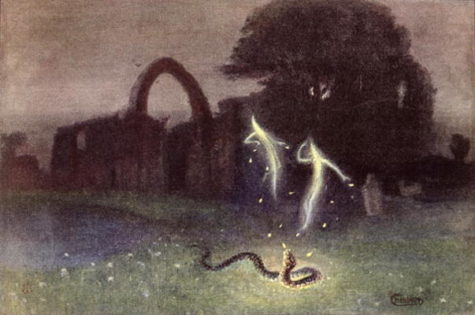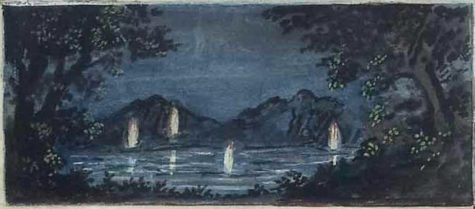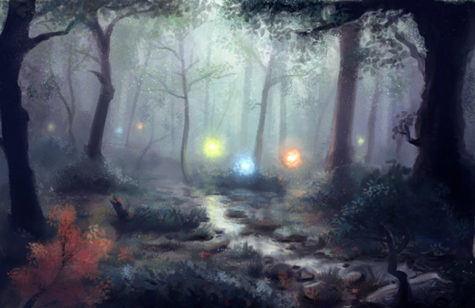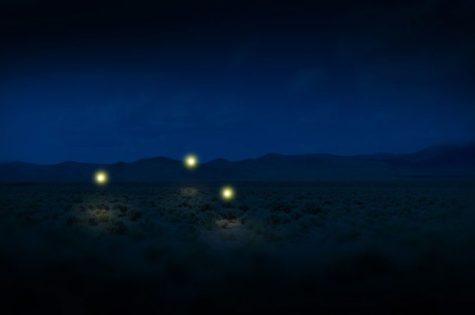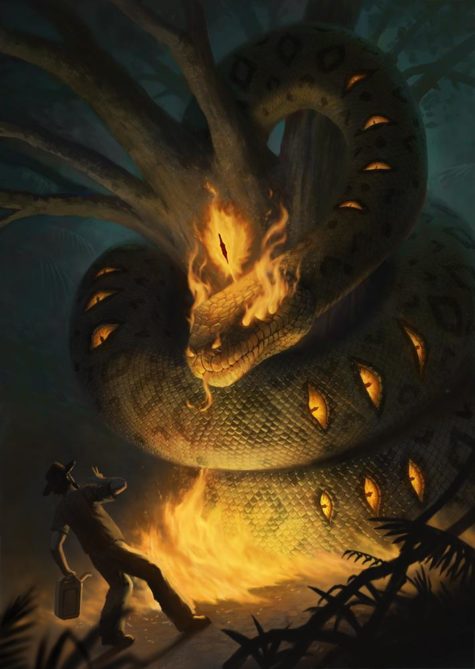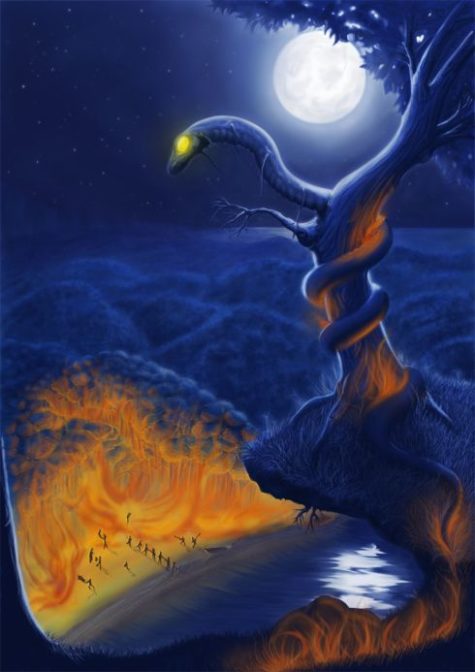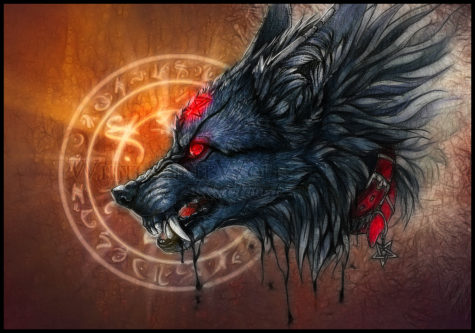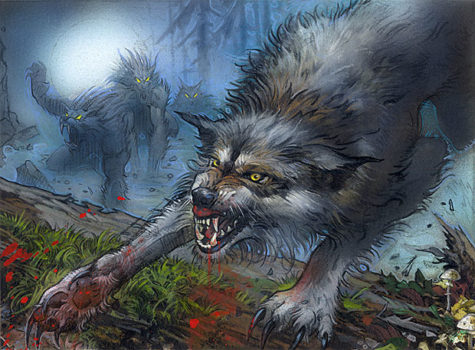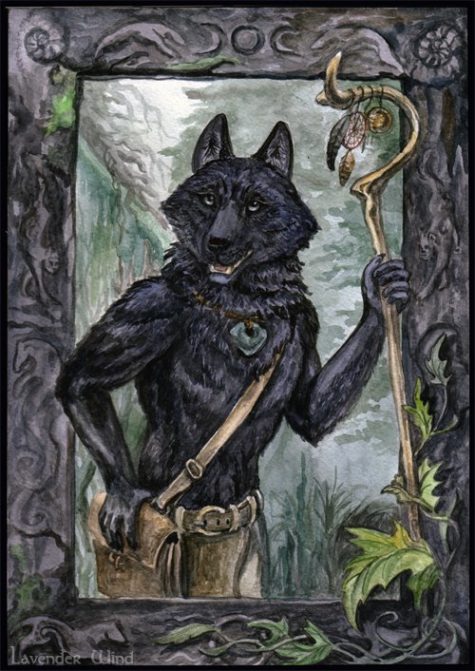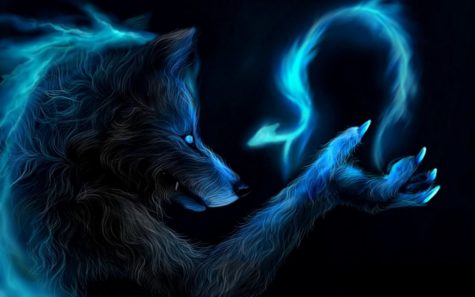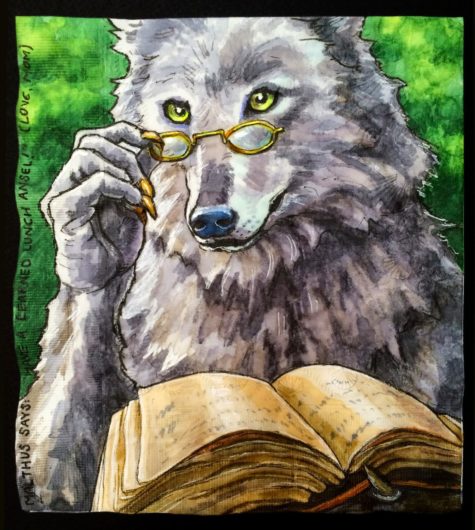Legendary Creatures
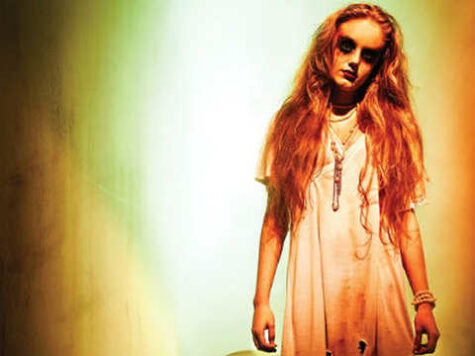
Brazil has its fair share of urban legends, some of them terrifying. Take the legend of the Loira do Banheiro (the bathroom blonde), for instance. This legend tells the tale of an amazingly beautiful girl with long blonde hair who killed herself (or was killed) in a bathroom.
In some stories, she is a bride ghost who lives inside the last stall of every public bathroom. Her soul is trapped there, and she must spend the rest of eternity scaring the crap out of people who show up to do their business.
There are other blonde woman legends as well, including one that involves a blonde on the street who tricks men into giving her a lift, then tries to murder them.
Popular Versions of the Loira do Banheiro Story:
They say she is the ghost of a dead girl with long blond hair. Her nose and mouth are stuffed with bloody cotton, blood streams from her empty eye sockets and her skin is covered in small cuts. Some say she appears in the mirror and stares at you and others say she asks you to take the cotton out of her nose.
To make her appear, you must go to the last stall in the bathroom and kick the door 3 times, flush the toilet 3 times, turn a tap on and off 3 times and say a curse word out loud 3 times.
According to this legend, she was once a beautiful blonde girl who always skipped classes and hung out in the school bathroom, smoking, drinking alcohol and generally getting up to no good. Then one day, during these escapades, she slipped on the wet bathroom floor and hit her head on a toilet and bled to death.
Not satisfied with her premature and tragic end, her soul would not rest in peace, and since that day, the toilets of schools are haunted by the spirit of the dead blonde.
In another legend, her name was Maria Augusta and she was the daughter of a Brazilian viscount. At the tender age of 14, her parents forced her to marry a man she didn’t love. He was also much older than her and she was very unhappy in the marriage.
She ended up having an affair with another man and she ran away to Europe with her lover. Unfortunately she died of pneumonia and her remains were shipped back to her parents. They say that at the exact moment of her death, a mirror in her parents house shattered. Her parents put her body on display in a glass case and refused to bury her.
There is yet another legend that claims the blonde in the bathroom was once a teacher who fell in love with one of her students. When her husband found out, he flew into a jealous rage and murdered her.
First he stabbed her and sliced her face to ribbons, then he stuffed her head down one of the school toilets until she drowned.
An Eyewitness Account:
It all started when this girl in my class started reading about urban legends on the internet and found the famous legend of the blonde in the bathroom. She told all of us that she was going to do the ritual. She did everything right and she was alone in the bathroom with the door locked. I don’t know what happened while she was alone in there, but when she came out she acted like nothing had happened.
When we asked her if the ritual worked, she was like, “What are you talking about?” She couldn’t remember anything about it. When one of my friends mentioned something about the blonde in the bathroom, the girl suddenly began to bang her head on the table, her eyes turned back in her head and she gave a horrible screech. Her parents had to come and take her home. When she came back to school a few days later, she said, “I don’t know, I do not remember anything!”
Another Eyewitness Account:
When I was little I was always fascinated by the supernatural. One day my friend and I were in school when we heard someone screaming from the second floor. We ran up there and what we saw was incredible.
We saw many people gathered around the door of the bathroom and just as we were going to see what was going on, we saw a student running scared and crying. There was a woman following her with a bloody nose, bloody face, and her skin was all torn and bleeding. Most importantly, she was blonde.
After a while, we saw two nuns coming and the blonde ran into the bathroom. When the nuns opened the door, the bathroom was empty. She disappeared. To this day, I can still remember that face.
Sources:
The Headless Mule or Mula-Sem-Cabeça, is a mythical character in Brazilian folklore. The Mule’s appearance varies greatly from region to region. Its color is most commonly given as brown, sometimes as black. It has silver (or iron) horseshoes that produce a hideous trotting sound, louder than any horse is capable of producing.
The legend of the mula tells of a girl or woman who was cursed for having relations with a priest. As punishment for her part in a man of God’s sin, she is condemned to transform into a wild mule with fire in place of a head, shooting flames from its nonexistent nostrils and stampeding through villages at night. In the morning, she reverts to her human form, waking up naked and unable to remember a thing.
Transformation usually occurs at a crossroads. Depending on the source the headless mule may have a placeholder head and mane, made of the fire it spews, to which a red-hot iron bridle is tied.
Despite being headless, the Mule still neighs (usually very loud), and sometimes it moans like a crying woman. Is said to produce a piercing, terrifying noise during its rampage, and the clattering of its gold or silver shoes strikes fear into all who hear it. If you get too close, it might kick you into the afterlife.
To successfully hide from the mula, you must ensure specific body parts are concealed from its sight, as it seems to enjoy eating eyes, thumbs, teeth, etc., depending on which version of the legend you recall while in the process of dying of fright.
The transformation can be reversed temporarily by spilling the mule’s blood with the prick of a needle or by tying her to a cross. In the first case, transformation will be prevented while the benefactor is alive and lives in the same parish in which his feat was accomplished. In the second case the woman will remain in human form until the sun dawns, but will transform again the next time.
A more stable removal of the curse can be achieved by removing the bridle, in which case the woman will not shape shift again while the benefactor is alive. Tying the bridle back to the woman’s mouth will return the curse.
Removal of the curse is a great relief for the woman because the curse includes many trials, so the grateful woman will usually repent her sins and marry the benefactor. In any case, when the mule changes back to human form the accursed woman will be completely naked, sweated, and smelling of sulfur.
A person who encounters the mule should not cross its path, or the mule will follow the offender and trample him down. Instead, one should either be brave enough to remove the bridle or spill its blood, or else just lay face down on the ground, covering teeth and nails (as well as anything that shines) and the mule will hopefully fail to notice the stranger’s presence and trot away (because it has poor vision).
Some versions of the legend curse the priest instead of the woman, usually following a twist where the aforementioned relations are violently one-sided in the priest’s favor. Some also say the mula is a girl who lost her virginity outside of marriage. A third, more fantastic version involves a queen who had a bad habit of digging up kids’ graves and eating the corpses… until the king caught her in the act, whereupon she transformed into the mula and charged headlong into the night.
Sources:
The Jack-o’-lantern is carried by a drunkard named Jack. Jack sold his soul to the devil, so that the devil would pay his pub tab. When the devil returned from the pub to collect Jack’s soul, the man tricked him into climbing a tree, then drew a cross under the tree, trapping the furious devil in its branches. Later, when Jack died and was rejected at heaven’s gates, he had to beg the devil for a place in hell. The devil was delighted at his chance to get revenge. He cursed Jack to wander the earth, with only a small frame for light. Jack put this flame in a carved turnip and used it as a lantern.
The Ignisfatus, or exhalation termed “Will-with-a-Whisp,” or “Jack-with-a-Lanthorn,” which is sometimes seen in churchyards, or marshy and fenny places in summer and autumn, was considered by many old inhabitants in this neighborhood, when the author was in his infancy, to be a kind of device of the evil spirit to draw human beings from the road they were pursuing into some frightful abyss of misery; and there leave them without any hope of regaining the enjoyment of happiness in the land of the living.
Stories of the origins of the jack o’ lantern are many and varied. Here are some of the ones I found:
- A Stupid Devil
A popular legend giving the origin of the jack-o’-lantern in Wales deals with the idea of a stupid devil. A long time ago there lived on the hills of Arfon an old man of the name of Sion Dafydd, who used to converse much with one of the children of the bottomless pit.
One morning Sion was on his way to Llanfair-Fechan, carrying a flail on his shoulder, for he had corn there, when whom should he meet but his old friend from the pit, with a bag on his back, and in it two little devils like himself. After conversing for some time they began to quarrel, and presently were in the midst of a terrible fight. Sion fell to basting the devils with his flail, until the bag containing the two little ones went all to pieces, and the two tumbling out, fled for their lives to Rhiwgyfylchi, which village is considered to this day a very wicked place from this fact.
Sion then went his way rejoicing, and did not for a long time encounter his adversary. Eventually, however, they met, and this time Sion had his gun on his shoulder.
“What’s that long thing you’re carrying?” inquired the devil.
“That’s my pipe,” said Sion.
Then the devil asked, “Shall I have a whiff out of it?”
“You shall,” was Sion’s reply, and he placed the mouth of his gun in the devil’s throat and drew the trigger. Well; that was the loudest report from a gun that was ever heard on this earth.
“Ach! – tw! – tw!” exclaimed the smoker, “your pipe is very foul,” and he disappeared in a flame.
After a lapse of time, Sion met him again in the guise of a gentleman, but the Welshman knew it was the tempter. This time he made a bargain for which he was ever afterwards sorry, i.e., he sold himself to the devil for a sum down, but with the understanding that whenever he could cling to something the devil should not then control him.
One day when Sion was busily gardening, the evil one snatched him away into the air without warning, and Sion was about giving up all hopes of again returning to earth, when he thought to himself, “I’ll ask the devil one last favor.”
The stupid devil listened.
“All I want is an apple,” said Sion, “to moisten my lips a bit down below; let me go to the top of my apple tree, and I’ll pick one.”
“Is that all?” quoth the devil, and consented.
Of course Sion laid hold of the apple tree, and hung on. The devil had to leave him there. But the old reprobate was too wicked for heaven, and the devil having failed to take him to the other place, he was turned into a fairy, and is now the jack-o’- lantern.
- The Welsh Story of Lantern Jack
This is one of the apparitions of the night, and one of the most mischievous and tricky of the ghostly family. What form or color he has we know not, as no one has ever clearly seen him; his lantern has been seen, and he has been heard splitting his sides with laughter at his own tricks, and the perplexity of those whom he might have led astray; and people say that his laugh was not unlike the loud sudden neighing of a horse.
His light was seen on dark nights like a lighted lantern on the sheep-paths on the hillsides. If he happened to be far off, no one was deceived, as his ungainly movements betrayed him as “Lantern Jack in search of his sheep,” and as the saying goes:
An ignis fatuus
Deceives not many of us.
The time when he generally succeeded with his mischief was when he found someone all alone travelling a path on open fields. He would begin by appearing as a small speck of fire, of a clear blue flame, which he moved before the wayfarer along the middle of the path until his attention had been secured; then the flame would gradually grow until its brightness would completely blind him, after which the traveler was entirely at Jack’s mercy, and he would lead him where he pleased.
Stories are related of men who have been led miles out of their way in this manner, especially young men going to see their sweethearts on dark winter nights.
- The Spirits of Unrighteous Men
Jack o’ lanterns are the spirits of unrighteous men, which by a false glimmer seek to mislead the traveler, and to decoy him into bogs and moors. The best safeguard against them, when they appear, is to turn one’s cap inside out.
When any one sees a Jack o’ lantern, let him take care not to point at him, for he will come if pointed at. It is also said that if any one calls him, he will come and light him who called; but then let him be very cautious.
Near Skovby on the isle of Falster there are many Jack o’ lanterns. The peasants say they are the souls of land-measurers who in their lifetime had perpetrated injustice in their measurements, and therefore run up Skovby bakke at midnight, which they measure with red hot iron rods, crying, “Here is the clear and right boundary! from here to there!”
- Another Jack o’ Lantern Story
There is, however, another story as to the origin of the jack o’ lantern. The haunting spirit is that of a blacksmith, who could get no admittance even into hell. He was very cold, and begged for a single ember to warm himself, and at last one was given him, and he has gone shivering about with it ever since.
- Jack o’ Lanterns Baptized
Jack o’ Lanterns are, as tradition tells us, the souls of unbaptized children. Because these souls cannot enter heaven, they take their abode in forests, and in dark and desert places, where they mourn over their hard lot. If at night they get sight of any person, they run up to him, and then hasten on before him, to show him the way to some water, that he may baptize them therewith. And that no one should neglect to do, because the poor beings must remain without the gates of paradise until some one takes pity on them.
Sources:
No after-death spirit retains as much fascination for the living as does the vampire. Popularly known as the un-dead, many understand vampires to exist on a plane somewhere between the realms of the living and the dead. Are vampires tortured souls of the dead, compelled to feed upon the living? Or are they souls rewarded with eternal life, able to achieve the alchemist’s ultimate fantasy without spending endless hours shut up in a laboratory?
Who or what exactly are vampires? Interpretations differ; “vampire” is a catch-all word that encompasses many concepts. However, one quality is held in common by all vampires: they suck vitality from others.
The most notorious literary and cinematic vampires, like Bram Stoker’s Dracula, Sheridan Le Fanu’s Carmilla, or the inhabitants of Anne Rice’s novels, are blood-suckers. Some vampires kill their victims by draining them of all their blood immediately. More sensuous vampires prolong the process: it isn’t the loss of blood that ultimately kills the victim. The blood is merely the means for the vampire to drain the victim’s life force away?
Another interpretation suggests that a vampire may not be dead at all but a living sorcerer able to send out his or her shadow soul (and recall it when desired) and that this soul is interpreted by others as a vampire.
The Historical Vampire
The concept of vampirism dates back thousands of years. The ancient Greeks, Hebrews, Egyptians and Babylonians all had legends telling hair-raising tales of demon-like un-dead creatures that lived off of the blood of the living.
Tales of the un-dead consuming the blood or flesh of living beings have been found in nearly every culture around the world for many centuries. Today we know these entities predominantly as vampires, but in ancient times, the term vampire did not exist; blood drinking and similar activities were attributed to demons or spirits who would eat flesh and drink blood; even the devil was considered synonymous with the vampire.
Almost every nation has associated blood drinking with some kind of revenant or demon, from the ghouls of Arabia to the goddess Sekhmet of Egypt. Indeed, some of these legends could have given rise to the European folklore, though they are not strictly considered vampires by historians when using today’s definitions.
Hebrews, ancient Greeks, and Romans had tales of demonic entities and blood-drinking spirits which are considered precursors to modern vampires. Despite the occurrence of vampire-like creatures in these ancient civilizations, the folklore for the entity we know today as the vampire originates almost exclusively from early 18th-century Southeastern Europe, particularly Transylvania as verbal traditions of many ethnic groups of the region were recorded and published. In most cases, vampires are revenants of evil beings, suicide victims, or witches, but can also be created by a malevolent spirit possessing a corpse or by being bitten by a vampire itself. Belief in such legends became so rife that in some areas it caused mass hysteria and even public executions of people believed to be vampires.
In India, tales of vetalas, ghoul-like beings that inhabit corpses, are found in old Sanskrit folklore. Although most vetala legends have been compiled in the Baital Pachisi, a prominent story in the Kathasaritsagara tells of King Vikramāditya and his nightly quests to capture an elusive one. The vetala is described as an undead creature who, like the bat associated with modern-day vampirism, hangs upside down on trees found on cremation grounds and cemeteries. Pishacha, the returned spirits of evil-doers or those who died insane, also bear vampiric attributes.
The Hebrew word “Alukah” (literal translation is “leech”) is synonymous with vampirism or vampires, as is “Motetz Dam” (literally, “blood sucker”). Later vampire traditions appear among diaspora Jews in Central Europe, in particular the medieval interpretation of Lilith. In common with vampires, this version of Lilith was held to be able to transform herself into an animal, usually a cat, and charm her victims into believing that she is benevolent or irresistible. However, she and her daughters usually strangle rather than drain victims, and in the Kabbalah, she retains many attributes found in vampires.
A late 17th- or early 18th-century Kabbalah document was found in one of the Ritman library’s copies of Jean de Pauly’s translation of the Zohar. The text contains two amulets, one for male (lazakhar), the other for female (lanekevah). The invocations on the amulets mention Adam, Eve, and Lilith, Chavah Rishonah and the angels—Sanoy, Sansinoy, Smangeluf, Shmari’el, and Hasdi’el. A few lines in Yiddish are shown as dialog between the prophet Elijah and Lilith, in which she has come with a host of demons to kill the mother, take her newborn and “to drink her blood, suck her bones and eat her flesh”. She informs Elijah that she will lose power if someone uses her secret names, which she reveals at the end.
Other Jewish stories depict vampires in a more traditional way. In “The Kiss of Death”, the daughter of the demon king Ashmodai snatches the breath of a man who has betrayed her, strongly reminiscent of a fatal kiss of a vampire. A rare story found in Sefer Hasidim #1465 tells of an old vampire named Astryiah who uses her hair to drain the blood from her victims. A similar tale from the same book describes staking a witch through the heart to ensure she does not come back from the dead to haunt her enemies.
How does one become a vampire?
Although some spirits are believed to be innately vampiric, transcending rhyme or reason, Different traditions cite different causes, some much crueler than others if one considers the implications.
In actual Transylvanian folklore, illegitimate sons, born outside Church-sanctioned marriages, are doomed to become vampires. Ukranian folklore perceives vampires as the inevitable result of sexual relations between witches and werewolves.
And so we find that people can become vampires not only through a bite, but also if the following situations were to occur:
- According to other legends, those born on Christmas Day are potentially future vampires.
- Were an illegitimate child of parents who were illegitimate.
- Died before baptism.
- Anyone who has eaten the flesh of a sheep killed by a wolf.
- If you were the child of a pregnant woman who was looked upon by a vampire.
- You were given inadequate, improper funeral rites.
- If you are a nun who stepped over an unburied body.
- If you had teeth when you were born.
- Or maybe you were once a werewolf.
- You practiced sorcery before your death.
- A cat jumped on your corpse before you were buried (England and Japan).
- A baby born with teeth.
- A stillborn.
- A bat flying over a corpse (Romania).
- Being excommunicated by the Orthodox Church (Greece).
- Being the seventh son of the seventh son.
- A dead body that has been reflected in a mirror.
- Red heads (Greece).
- People who die by suicide or sudden, violent deaths.
- People who were improperly buried; renouncing the Eastern Orthodox religion.
In folklore, the vampire’s first victim would often be his wife. This is why, in some cultures, when a husband died, the wife would change her appearance, i.e. she would cut her hair and would wear black for the entire period of mourning. These things were done with the intention of deceiving the vampire, should he return.
According to some legends, a vampire may engage in sex with his former wife, which often led to pregnancy. In fact, this belief may have provided a convenient explanation as to why a widow, who was supposed to be celibate, became pregnant. The resulting child was called a gloglave (pl. glog) in Bulgarian or vampirdzii in Turkish. Rather than being ostracized, the child was considered a hero who had powers to slay a vampire.
A completely different idea of how vampires are made can be found in this article by J.L.N. Lewitin.
- Intimate infection from a demon:
There is a contagious quality to being a vampire. One vampire infects, initiates and creates another. Having been attacked by a blood-sucking vampire, according to this school of thought, one either becomes a vampire oneself or dies.
When a vampire, or demon, infects a mortal in such a way that they bind with the physical body of the creature, they can often pry the soul out of control of the body and permanently remove it. The power of the demon fuels the initial removal of the soul, as well as the first few hours of action. After this, most vampires will require the blood or soul of other conscious beings. Over time the demon will become more efficient at extracting the energy from these sources, and will require less. However initially, the need will be quite great.
This method of infection can also be transmitted to other conscious beings through the sharing of blood. In this way the demon within the initial vampire can multiply itself. The power of the second vampire will be slightly less then its makers, however over time it will also increase. There is also some speculation that when the initial vampire is destroyed, if the demon is eradicated with it, that all of the vampires born of that demon will also be destroyed.
These vampires tend to be the most powerful, and possess the strongest attributes. This is because the energy of the demon fuels the initial transformation, and the first few hours of existence. The demon also helps the body to become accustomed to its new existence, and can synthesize the souls or blood of other creatures, making it a useable source of energy. They also make it easier for the body to tap into telekinetic, psychic, and magical powers, as well as the new physical power within its body.
- Infection from a virus:
Some viruses can cause a change in the body which destroys it in such a way that the soul fleas, but the physical brain retains some control over the creature’s actions. Initially such beings will be extremely weak and may be mistaken for dead. However, if they gain a source of energy, and a way to synthesize it into something they can use, they may be able to cobble together a consciousness. Their energy source may be the blood or souls of humans, or might be some other form of magic or chemical energy.
These vampires are marked by weakness, and a lack of consciousness. They are often compared to zombies, with the main difference being that vampires do not seam to degenerate after the initial change, while zombies are in a constant state of decline.
- Vampirism by mental disease:
In rare cases a person’s physical mind can become obsessed with the sensual body to such an extent that it begins to revolt against the creatures inner soul. This is usually a violent struggle, and can be very painful and difficult for the victim.
As the soul is removed the creature begins to require alternate sources of energy to fuel its consciousness. In these scenarios, blood or souls are as likely as any other source to become the fuel, as the creature does not possess the ability to synthesize blood into a useable form. Some cases have been observed where vampires of this type become voracious eaters, others draw their energy from fire, and others use magical means to fuel themselves.
Traditional Vampires
Contrary to popular Hollywood movies, blood-sucking vampires tend to be an aberration. Although they did exist prior to Bram Stoker’s incredibly influential best-selling 1897 novell, Dracula, they were rare and very much a product of Gothic fiction.
Traditional folkloric vampires have comparatively little to do with many literary or movie vampires. Vampire traditions exist throughout virtually all of Eastern and Central Europe. Similar sounding words exist in Slavic, Finno-Ugric, and Romance languages. Variations include:
- Upir
- Wampir
- Vampyr
- Upior
Traditionally speaking, vampires are understood as revenants, living corpses of witches, sorcerers, shamans, and/or magickal practitioners who, for one reason or another, rise from the grave. At their most neutral, they are harmful merely because they are not obeying natural laws; at their worst, they rise with the deliberate intent to cause harm.
Although little or no notion of blood-sucking exists in the original conception, that doesn’t mean a vampire isn’t potentially dangerous. Because vampires may be in a liminal state, between life and death, they require life-energy, which is easiest absorbed from the living. However this life force is more likely to be absorbed via sexual energy or siphoning off “chi” rather than sucking blood. From this perspective, Fox Spirits who sexually drain men to the point of death are considered vampiric.
Identifying Vampires
While most people can name several elements of vampire lore, there are no firmly established characteristics. Some vampires are said to be able to turn into bats or wolves; others can’t. Some are said not to cast a reflection, but others do. Holy water and sunlight are said to repel or kill some vampires, but not others. The one universal characteristic is the draining of a vital bodily fluid, typically blood.
One of the reasons that vampires make such successful literary figures is that they have a rich and varied history and folklore. Writers can play with the “rules” while adding, subtracting or changing them to fit whatever story they have in mind.
Finding a vampire is not always easy: according to one Romanian legend you’ll need a 7-year-old boy and a white horse. The boy should be dressed in white, placed upon the horse, and the pair set loose in a graveyard at midday. Watch the horse wander around, and whichever grave is nearest the horse when it finally stops is a vampire’s grave — or it might just have something edible nearby; take your pick.
Often potential revenants, or vampiric spirits, can be identified at birth, usually by some abnormality, some defect, as when a child is born with teeth. Similarly suspicious are children born with an extra nipple (in Romania, for example); with a lack of cartilage in the nose, or a split lower lip (in Russia). When a child is born with a red caul, or amniotic membrane, covering its head, this was regarded throughout much of Europe as presumptive evidence that it is destined to return from the dead.
Banishing and Destroying Vampires
The best way to deal with vampires, of course, is to prevent them from coming back in the first place. A few centuries ago in Europe this was often accomplished by staking suspected vampires in their graves; the idea was to physically pin the vampire to the earth, and the chest was chosen because it’s the trunk of the body.
This tradition was later reflected in popular fiction depicting wooden stakes as dispatching vampires. There was no particular significance to using wood; according to folklore, vampires — like djinn (genies) and many other magical creatures — fear iron, so an iron bar would be even more effective than a wooden stake.
It was also not unusual for a corpse to be buried face down so it would dig down the wrong way and become lost in the earth.
According to several legends, if someone was bitten by a suspected vampire, he or she should drink the ashes of a burned vampire. To prevent an attack, a person should make bread with the blood of vampire and eat it.
Other traditional methods of killing vampires include decapitation and stuffing the severed head’s mouth with garlic or a brick. In fact, suspected vampire graves have been found with just such signs.
If your local villagers neglected to unearth and stake a suspected vampire and he or she has returned from the grave, there are steps you can take to protect yourself.
The exact method varies around the world, but in some traditions the best way to stop a vampire is to carry a small bag of salt with you. If you are being chased, you need only to spill the salt on the ground behind you, at which point the vampire is obligated to stop and count each and every grain before continuing the pursuit. If you don’t have salt handy, some say that any small granules will do, including birdseed or sand. Salt was often placed above and around doorways for the same reason.
In Macedonian tradition, vampires can be prevented from causing harm by scattering millet seed throughout the cemetery. Any passing vampires are compelled to obsessively pick up every tiny seed, leaving them vulnerable to the banishing rays of the sun.
Traditional vampire repellents and banishers include, bright light or sunlight, garlic, hawthorn branches, rowan trees (later used to make crosses), peppermint, onions, a rooster’s crow, silver bullets, iron bells, bullets created from melted down bell metal, thresholds (unless they’re invited in), mirrors, decapitation with a gravedigger’s spade, salt (associated with preservation and purity), running water, fire, and burying a suspected vampire at a crossroads.
Some traditions hold that vampires cannot enter a home unless formally invited in. This may have been an early form of the modern “stranger danger” warnings to children, a scary reminder against inviting unknown people into the house.
Whether crosses and Church-blessed Holy Water also repels vampires or whether this is merely Christian propaganda is subject to debate. That being said, the following might possibly repel or deter a vampire: churches, crucifixes, eucharist water, holy water, Devotees of Japanese anime will recall that those methods have no effect on Vampire Princess Miyu.
To destroy a vampire, you can:
- Burn it.
- Bury the corpse facedown.
- Drive a wooden stake through its heart.
- Pile stones on the grave.
- Put poppy seeds or wild roses on the grave.
- Boil the head in vinegar.
- Place a coin in the mouth and decapitate with an axe.
- Put a lemon in the mouth.
- Bury at a crossroads.
- Remove the heart and cut it in two.
- Put garlic in the mouth and drive a nail through the temple.
- Cut off the toes and drive a nail through the neck.
- Pour boiling oil on the body and drive a nail through the navel.
More more spells and rituals to banish, deter, repel, and possibly even make peace with vampires can be found at the Book of Shadows and Gypsy Magick and Lore.
Metaphorically Speaking
Vampirism can be understood metaphorically as well as literally: that may not be just any old blood the vampire is draining. Menstrual blood may be perceived as symbolizing women’s mysteries and magick powers. The male vampire depicted preying upon a young woman may be perceived as either attempting to appropriate or annihilate her special power.
Literary and cinematic vampires typically possess a sexual element. To some extent that type of vampire combines the blood-sucker with more ancient incubus (male) and succubus (female). Incubi and succubi are spirits, vampiric creatures who suck and drain sexual vitality, often through sexual intercourse, whether actual physical intercourse or through dream hauntings. Although the visitations may occur in dreams, the severe devitalization is apparent upon awakening.
Philosophy of the Vampire
Vampires are born out of a fundamental change which can occur in the physical bodies of creatures which possess a soul. In most mortals the soul is the fundamental source for action, creating the original impulses which eventually become the person’s acts. It is also a passage through which the creature can gain a small amount of the infinite power underlying the universe, power which is necessary for the functioning of a self conscious being.
A vampire is born when a mortal creature undergoes a change which causes the sensual physical body to revolt against the soul, usually expelling it, and taking control of the creature. The actions of the being are then controlled by either the remaining physical brain, the remnant of the soul, whatever caused the expelling of the soul, or a conglomerate of these forces. It is this emphasis on the physical body to the exclusion of the soul, which causes many vampires to be obsessively sensual and addicted to their own suddenly intense perceptions.
There are many things which can cause a creature to become a vampire. These include certain forms of intimate demonic possession, various viruses, the casting of spells to become a vampire, or mental disease. Each of these causes has its own peculiar nature, and can result in very different outcomes for the victim.
The change into a vampire is almost always accompanied by physical changes in the creature’s body. The most common of these is a removal of the ability to feel pain, and a fundamental change in their perception of the world. These are caused by the sudden lack of soul, which influences the way everything looks and feels.
The immortality of the creature comes due to a perceptual change. The body in complete control of itself does not choose to harm itself with entropy, and so stops doing it. However it is the soul which provides a creature with true wisdom and this form of immortality almost always results in major psychological problems. While immortal, eventually almost all vampires end up committing suicide due to the pressure of their own thoughts.
Changes such as an increase in strength, the ability to fly, psychic and telekinetic powers, and magic abilities are fueled by a power source which accompanies the transformation. As such these abilities are dependent on the amount of energy within the being, and will be increased or decreased by this factor.
Energy is a major problem for vampires, who have to fuel a self conscious existence without the benefit of the soul’s pathway to the infinite power source. If a demon initiates the change, then their inherent power will fuel the initial act. If the change occurs due to a mental problem, or a mental problem caused by a virus, then the remnants of the soul and the body itself will have to fuel the initial change. This often results in vampires of very low consciousness and power.
Later energies have to come from another source, as even the initial power of a demon can not fuel a conscious being for long. This power is often gained through the drinking of the blood or souls of other self conscious creatures. Unfortunately the drinking of a soul, or soul blood, will only give a creature a limited amount of energy, requiring that the vampire repeat this act on a regular basis to survive.
The need for energy can become an obsession in vampires, overwhelming any sense of control and self they may have once had. If the need becomes too great, it can utterly destroy whatever mind remains in the creature, turning them into a zombie.
Some experiments have been done with plasma, as well as nuclear and subatomic energy sources as a way of fueling vampires. This technology is still in its infancy however, and most of the vampiric test subjects claim that these methods are still too weak to effectively sustain them.
Weaknesses Of The Vampire
The greatest weakness vampire’s face is their need for energy, often in the form of blood. Since consuming the blood and souls of conscious beings is generally opposed by the conscious beings themselves, vampires have a constant enemy that they are intrinsically tied to. They can’t live with their prey, but they can’t live without them.
If a vampire finds a way to synthesize enough energy to survive, they will usually develop a second problem. As a creature increases its ability to take energy from subtle existences such as life, they will become more sensitive to the energy in the world around them.
Generally if the vampire becomes good enough at synthesizing energy from blood or souls to survive, they will also become so sensitive to energy that sources such as the sun and fire will be extremely harmful to them. This is why many traditional demon induced vampires, who enjoy instant acclimation to vampirism, also suffer from the inability to go out in daylight. However there can be a convergence point for some vampires where they become so good at synthesizing energy that their power increases faster then their bodies sensitive to light and heat, and they become impervious to them once again.
Sources:
- Live Science
- The Pagan Calendar
- Encyclopedia of Spirits
- Element Encyclopedia of 5000 Spells
- Ancient Thoughts
- Thought Catalogue
The mapinguari (“roaring animal” or “fetid beast”) is basically the bigfoot of South America. This roaring beast wanders the forests of South America, tearing down brush and trees with its powerful claws and leaving behind a trail of destruction as it looks for food.
According to native folklore the creature has a series of unnatural characteristics related to other fantastic beings of Brazilian mythology. These include the creature only having one eye, long claws, lizard-like skin, backward feet, and a second mouth on its belly. In more recent alleged eyewitness accounts, it has consistently been described as resembling either an ape or giant ground-dwelling sloth and having long arms, powerful claws that could tear apart small trees, a sloping back, reaching heights of 7 feet when standing on its hind legs, and covered in thick, matted fur.
This cryptid is described as a giant smelly beast that can stand on its feet like a grizzly, having the face of a monkey and thick fur over skin tough enough to stop a shotgun round in its tracks. Some sources have reported it sporting a second mouth in the middle of its belly, which emits a disgusting odor that leaves men dizzy, confused, and unconscious.
According to legend, it is slow but ferocious and very dangerous due to its ability to move without noise in the thick vegetation, surprising the unsuspecting locals. Accounts state that it gave off a putrid stench and emitted a frightening shriek, and that weapons such as arrows and bullets could not penetrate the Mapinguari’s alligator-like hide.
Its only known weakness is that it avoids bodies of water, which limits its movements in a region where so many rivers, brooklets and lagoons exist (especially during the rainy season). It was believed to be carnivorous, as a 1937 report from central Brazil claimed a mapinguari had gone on a three-week rampage, killing over 100 cows and ripping out the tongues from their carcasses. However, in all accounts it did not eat humans, although when it smells the presence of people it stands up on its back feet, becoming as tall as two metres, a movement similar to grizzly bears.
Often, people say the mapinguari serves as a sort of jungle protector, attacking those who take more resources than necessary. In this sense, it is similar to other legendary protector/punisher figures, like the boitatá and the curupira, a creature with backward feet who finds joy in confusing hunters.
According to Brazilian stories, the Mapinguari was once an Amazonian shaman who discovered the key to immortality thousands of years ago. He angered the gods and was severely punished as to his discovery, which forced him to be transformed into a wandering beast for the rest of his life.
Most sightings show the beast as a giant sloth, although a few see it as an ape-like creature. Most cryptozoologists speculate that the Mapinguari is either a Megatherium, a large giant ground sloth from the Ice Age that lived in the area, or another species of Giant Sloth.
There are accounts of this sort of creature that span tribal groups who have no contact with each other, and many similar stories from hunters, rubber tappers, and more. The ubiquity and consistency of these reports piqued the interest of some scientists. One, an ornithologist named Dr. David Oren, has arranged expeditions to search for the mapinguari, but so far has collected zero sightings and a bunch of hair and feces that turned out to be be the deposits of giant anteaters and the hair of small rodents.
One member of the Machiguenga tribe in Peru told another scientist, Dr. Glenn Shepard, that he had seen a mapinguari in a museum in Lima. That museum just so happens to include a display featuring a model of Megatherium.
Lucas Karitiana, a member of the Karitiana tribe in Brazil, insists his son encountered one in the forest, and, although he escaped unscathed, the whole surrounded area looked “as if a boulder had rolled through and knocked down all the trees and vines.”
Sources:
Will-o’-the-Wisp is the most common English designation for a family of fairy-beings characterized by their fiery appearance and their tendency to lead nighttime wayfarers astray. The term wisp refers to a twist of straw, used as a torch. Other names for these apparitions include:
- Hobby-Lantern
- Jack-o’-Lantern
- Jenny-Burnt-Tale
- Kitty-Candlestick
- Peg-a-Lantern
- Ignis Fatuus
- The Lambent Flame
A Will-o’-the-wisp is a phantom light that hovers in the wilderness, luring travelers away from the beaten path. Most of these lights haunt the moors and bogs of England, but they have been reported all over the world, under various names.
Characteristics and Qualities
Will-o’-the-wisps are very simple apparitions. They appear as balls of light, sometimes so bright that they hurt your eyes and other times so dim that you have to squint to see them. They usually have a blue-ish gleam to them, although red has also been reported.
In some rare sightings, a dark figure has been seen carrying the light, as if it was a torch or a lantern. Despite carrying a light, the figure is always too dark to be described in detail.
A light floating in the darkness might seem innocent, even friendly, but don’t be deceived. These attractive lights are almost always malevolent. They lead travelers onto dangerous land, perhaps a deep hole in a bog or a kingdom ruled by vicious fairies.
Aside from their ability to dazzle and tantalize travelers, Will-o’-the-wisps are also powerful omens. They appear to be able to predict the future, appearing to people before their deaths or flocking to the sight of a tragedy before it takes place. They might also reveal the place where a thief or a fairy has buried golden treasure.
Stories of Will-o’-the-wisps
“A wand’ring fire
Compact of unctuous Vapour, which the Night
Condenses, and the Cold environs round,
Kindled through Agitation to a flame,
Which oft, they say, some Evil Spirit attends,
Hovering and blazing with delusive Light,
Misleads th’ amaz’d Night-Wand’rer from his way
To bogs and mires, and oft through Pond or Pool,
There swallow’d up and lost, from succour far.”
~Milton
- The Original Will O’ the Wisp
The classic Will-o’-the-wisp is carried by a blacksmith named Will. Will was such a troublemaker that, when he died and went to heaven, he was sent back by Saint Peter, who told him to reform during his second life. Unfortunately, Will’s second life was even more monstrous than his first, so Saint Peter cursed him to roam the earth forever. The devil, impressed by Will’s evildoing, gave him a coal to warm himself on the cold earth nights. Instead, Will decided to use the coal to make a torch and lure innocent travelers into danger.
- The Teine Biorach
The will o’ the wisp (called in Gaelic Teine biorach = sharp fire) is said to be of quite modern appearance, at least in South Uist. It was first seen, it is said, in 1812, and is the haunting spirit of a young girl from Benbecula, who frequented the machair, or sandy plain beside the sea, in search of the galium verum, used in the dyeing of the local cloth or tweed.
Her sin was that of seeking to get an undue share of a product which should have been equally divided for the common good, and which has at all times to be husbanded as one of the plants which bind the sandy soil together where it has been redeemed from the sea.
A special interest of this story is that it tells against the common Hebridean tradition of a cold hell, a tradition one soon learns to accept in South Uist, the land of cold mist and sweeping winds, and damp, and drafts, and rain, where even the nether regions with a fire in them have a suggestion of comfort. Hell is therefore discouragingly known as “the place of the wind of the cold passages, or the wind of the cold channels.”
- A Mischievous Gnome
“How Will a’ Wisp misleads night-faring Clowns,
O’er Hills, and sinking Bogs, and pathless Downs.”
~Gay
The will-o’-the-wisp is a mischievous gnome who leads people astray at nighttime or in the fog, causing them to loose their way and end up in a swamp. He does this foremost with inquisitive people who purposely follow him. The best way to avoid him or to render him harmless is to stay away from the footpaths where he has power, and always to keep one foot in a wagon rut. He helps some people who have lost their way by leading them home, if they speak to him kindly and offer him a generous payment.
Once a person who had lost his way offered him two silver groschens if he would lead him home safely. The will-o’-the-wisp agreed, and finally they arrived at the lost man’s house. Happy that he was no longer in need of help, he thanked his guide; but instead of the promised payment, he gave him only a small copper coin. The will-o’-the-wisp accepted it, then asked if he could now find his way home by himself.
He answered, “Yes! I can already see my open front door.” But stepping toward it, he fell into some water, for everything he had seen had been only an illusion.
The will-o’-the-wisp takes special delight in tormenting drunks making their way homeward from a fair or an evening of drinking. He leads them astray, and when in their drunkenness they can go no further, preferring instead to sleep off their binge out of doors, then he burns them on the soles of their feet.
In some regions the people believe that will-o’-the-wisps are the souls of children who died without being baptized. They are seen especially atop graveyard walls. They disappear when one throws a handful of graveyard soil at them.
- Baptizing The Will-o’-the-Wisps
Late one evening a man was walking across a field, returning to Gandshoven from Molenbeek. Suddenly three will-o’-the-wisps came running toward him. Because this good man was accustomed to baptizing such, in order to redeem all three, he said, “I baptize you all in the name of the father and the son and the holy ghost.”
But then it did not go well for him, for in the same instant he saw that he was surrounded by more than a thousand will-o’-the-wisps, all wanting to be baptized. He baptized unceasingly, but ever more of them approached him, and this did not end until the cock crowed. Thus the man had to spend the entire night in the field.
- Will-o’-the-Wisps with Long Legs
A peasant from Hermsdorf, Germany was going home late one evening when he saw a will-o’-the-wisp. Being of a daring nature, he approached it. Without hesitating, the will-o’-the-wisp fled, and the peasant quickly followed after him.
Thick on his heels, he saw that it had tremendously long legs, and that its head consisted of tips of glowing fire. However, it instantly disappeared, and the peasant was barely able to find his way home in the dark.
- Will-o’-the-Wisps Banned with a Curse
In the vicinity of Storkow a preacher was driving home late one evening with his servant. Arriving at a certain place they saw a will-o’-the-wisp approaching them. It hopped about merrily in front of the horses. Soon there were more of them, and finally there were so many of them that the horses took fright and would not continue onward.
The pastor became frightened as well, and therefore he began to pray aloud, but the more he prayed, the more of them came.
Finally the servant said, “No. Stop that. You’re not making them go away. I’ll get rid of them!” With that he shouted, “Go away, in the devil’s name!” and they immediately disappeared.
- The Godorf The Will-o’-the-Wisp
The marshy peninsula which extends between Godorf and Rodenkirchen (in Germany) is said to be the favorite resort of the sprite known all along the Rhine as the Herwisch, and in England as the will-o’-the-wisp. This mischievous little creature is said to delight in leading unsuspecting travelers astray, and in playing all manner of pranks, but, like most practical jokers, he is quick to resent any attempt to make fun of him.
One day a maiden, passing across this stretch of ground at nightfall, began to sing all the songs she knew, to beguile the loneliness of the way and inspire her with courage. Having soon come to the end of her scanty repertoire, she carelessly sang a mocking ditty about the Herwisch, who, enraged at her impudence, came rushing toward her threateningly brandishing his tiny lantern.
With a cry of terror, the girl began to run, closely pursued by the sprite, who, in punishment for her derisive song, napped his wings in her face and frightened her so badly that she became an idiot.
Since then, the young people of Germany have never dared to sing the mocking refrain, and carefully avoid mentioning the Herwisch’s name after nightfall, lest they should in some way arouse his anger.
Related Creatures
In the Britain and Ireland alone, there are dozens of variations of the Will-o’-the-wisp. The most famous are the “Jack-o’-Lantern,” “Peg-a’-Lantern,” “Joan the Wad,” “Jenny with the Lantern,” “Hobbedy’s Lantern”, “Hinky Punk,” and “Spunkies.” They are, for the most part, believed to be carried by souls barred from heaven and hell or by devious fairy-folk.
In the Netherlands, the “Irrbloss,” “Iiekko,” and “Iygtemand” are said to be the souls of un-Baptized children, who try to lead travelers to water, where they can be Baptized. They might also be lights guarding buried treasure, which can only be found using a dead man’s hand or after eating seeds from a magical fern.
In Asia, the “aleya” and the “chir batti” are used by dead souls to mark the place where they died. In other places, goblins, pixies, witches, un-Baptized children, and even the devil are blamed for carrying these dangerous lights.
In Australia, “min min” lights follow travelers once they are spotted. If the traveler turns and tries to follow the light, however, they will never be seen again.
In South America, the “luz mala” and “la candileja” are evil spirits who carry ghost lights after death.
In the United States, ghost hunters prize any photo which has captured an “orb,” a ball of colored light which is believed to reveal the presence of a dead soul in the room. In the swampland of Louisiana, a phantom light called “fifollet” represents dark souls who have been sent back from heaven to do penance on earth.
The Lambent Flame
There was in every hollow
A hundred wrymouthed wisps.
—Dafydd ap Gwilym, 1340
The Will-o’-the-wisp has been recorded as flickering over marshy ground since at least the middle ages, as the quote above testifies. In the centuries that followed, dozens of antiquaries have recorded anecdotes and personal accounts of the ignis fatuus, with even Sir Isaac Newton mentioning them in his 1704 opus Opticks.
The lights have also been incorporated into modern literature, e.g. Dracula, and have even had a children’s television show named after them. The most commonly cited explanation for them is that they’re the product of ignited marsh gas: most likely slowly leaking methane whose ignition is triggered by phosphene (also called phosphine or phosphorus hydride).
Historical and contemporary accounts of these lights, however, often fly in the face of this explanation given that the lights are often seen to move, and to not emit heat.
Some of their synonyms reveal what cultures thought about them: “treasure lights”, of Danish origin, suggests that they are the marking places of treasure; “corpse candles” suggests that they’re the souls of the departed; “fairy lights”, which now mean quite a different thing, suggest that they’re the work of (or indeed are) fairies.
The phenomenon is also inextricably linked with the leading astray of weary travelers into mires. The light was taken to be a lantern or a torch carried by a mischievous spirit, as is indeed reflected in the name Will-o’-the-wisp itself, which has an etymology of “William of the wisp [of lighted hay]”. The man of the lantern was said to play tricks on people, as in the case of the gentleman who was knocked off his horse by the Lantern Man of Horning, Norfolk in the 18th century*.
As quoted by Wilkie (1996), in 1778 William Pryce wrote in Mineralogia Cornubiensis that tinners would use anomalous light forms to find veins of tin: “another way of finding veins […] is by igneous appearances of fiery coruscations. The Tinners generally compare these effluvia to blazing stars.”
The westcountry seems to have held the phenomenon in generally high regard, in fact, for Dr. Jonathan Couch (or his son, Thomas Quiller-Couch) quotes a poem* in his History of Polperro that is reminiscent of the practice of using foxfire to guide one back home through forest:
Jack o’ the lantern! Joan the wad,
Who tickled the maid and made her mad;
Light me home, the weather’s bad.
Explanations of the Myth
Although they may not be trapped in lanterns held by the devil or hover over sunken fairy gold, Will-o’-the-wisps are a very real phenomenon. These mysterious lights do exist, and for a long time, they could only be explained through superstition.
Today, science has a few explanations (which don’t involve ghosts, devils, witches, or fairies) for the lights.
Some scientists believe that the light is produced by a type of bioluminescent fungus or algae that grows in marshy areas. Just like fireflies or angler fish, these plants could undergo a unique chemical process to produce light.
Still more scientists claim that a mixture of gases is responsible for the lights. In marshes, plant material often sinks underwater before it can decompose. In the water, the material undergoes an unusual type of decomposition, which releases methane, carbon dioxide, nitrogen, and phosphines into the air. Methane is a highly flammable gas, and phosphines have been known to spontaneously combust when they come into contact with air. Combine these two chemicals, and you could easily produce a burning ball of light hovering above a marsh.
Sources:
- Alternate Names: Baitatá, Biatatá, Bitatá, Batatão, Batatá, Mboitatá, M’boiguaçu, Mbaê-Tata
- Origins: Brazilian mythology, legend and folklore
- Element: Fire, Water
- Species: Serpent
- Appearance: Flaming, bright, giant horned aquatic serpent, or glowing eyes in the dark
- Powers: Protects the Rainforest
- Manifestation: A giant snake with enormous fiery eyes that crawls over the open fields at night. Sometimes described as a giant fire snake.
Boitatá is a mythological serpent from Brazilian mythology, legend and folklore. It is the Brazilian equivalent of the will-o’-the-wisp. The name comes from the Old Tupi language and means “fiery serpent” (mboî tatá). Its great fiery eyes leave it almost blind by day, but by night, it can see everything.
The Boitatá is a good entity, but it may kill anything which is violating the forests. Their diet consists of eyes from dead animals or its victims.
According to the legend, there was once a long period of darkness when the sun did not shine and a deluge flooded the earth. These conditions killed many animals and forced the beasts to flee their natural habitat. A “boiguaçu” (a cave anaconda) left its cave after the deluge and, in the dark, went through the fields preying on the animals and corpses, eating exclusively its favorite morsel, the eyes of the dead, which shone brightly in the darkness and made for tasty delicacies.
As the snake ate more and more of these delicious, shiny eyes, its body began to shine. The collected light from the eaten eyes gave “Boitatá” its fiery gaze, but the eyes-only diet steadily weakened it, and it perished… in a blaze of glory. For, upon its death, all the light collected inside it escaped to the sun, and the dark days were finally over.
There must have been some magic in all those eyeballs, because the boitatá lived on in spirit. It inhabits the Amazon jungles to this day, often appearing at night as nothing but two glowing, fiery eyes. Some say it can breathe fire as well, an ability it uses to incinerate people who harm the rainforest by chopping trees down or starting fires.
Others say it can actually disguise itself as a tree trunk, then roast alive any lumberjack who comes to cut it down. It is also said that it will blind you and make you insane if you gaze into its eyes.
Variations:
There are other versions of the legend that describe the boitatá as a giant, fiery bull who hunts the hunters, and yet others that associate it with almas penadas – souls that are cursed for various reasons, from immorality to dealing dishonestly with the devil.
Many descriptions of the boitatá legend connect it with ignis fatuus, or that fiery phenomenon known as the will-o’-the-wisp. There is some overlap between the legends of the boitatá and the boiúna, an evil black snake that is said to take a variety of forms, attack and devour people, and use its flaming eyes to lead boats to their ruin.
Sources:
The werewolf is a mythological animal and the subject of many stories throughout the world—and more than a few nightmares. Werewolves are, according to some legends, people who morph into vicious, powerful wolves. Others are a mutant combination of human and wolf. But all are bloodthirsty beasts who cannot control their lust for killing people and animals.
Early Werewolf Legends
It’s unclear exactly when and where the werewolf legend originated. Some scholars believe the werewolf made its debut in The Epic of Gilgamesh, the oldest known Western prose, when Gilgamesh jilted a potential lover because she had turned her previous mate into a wolf.
Werewolves made another early appearance in Greek mythology with the Legend of Lycaon. According to the legend, Lycaon, the son of Pelasgus, angered the god Zeus when he served him a meal made from the remains of a sacrificed boy. As punishment, the enraged Zeus turned Lycaon and his sons into wolves.
Werewolves also emerged in early Nordic folklore. The Saga of the Volsungs tells the story of a father and son who discovered wolf pelts that had the power to turn people into wolves for ten days. The father-son duo donned the pelts, transformed into wolves and went on a killing rampage in the forest. Their rampage ended when the father attacked his son, causing a lethal wound. The son only survived because a kind raven gave the father a leaf with healing powers.
Infamous Werewolves
Many so-called werewolves from centuries ago were in fact serial killers, and France had its fair share. In 1521, Frenchmen Pierre Burgot and Michel Verdun allegedly swore allegiance to the devil and claimed to have an ointment that turned them into wolves. After confessing to brutally murdering several children, they were both burned to death at the stake. (Burning was thought to be one of the few ways to kill a werewolf.)
Giles Garnier, known as the “Werewolf of Dole,” was another sixteenth-century Frenchman whose claim to fame was also an ointment with wolf-morphing abilities. According to legend, as a wolf he viciously killed children and ate them. He too was burned to death at the stake for his monstrous crimes.
Whether Burgot, Verdun or Garnier were mentally ill, acted under the influence of a hallucinogenic substance or were simply cold-blooded killers is up for debate. But it likely didn’t matter to superstitious Europeans during the 16th century. To them, such heinous crimes could only be committed by a horrific beast such as the werewolf.
The Bedburg Werewolf
Peter Stubbe, a wealthy, fifteenth-century farmer in Bedburg, Germany, may be the most notorious werewolf of them all. According to folklore, he turned into a wolf-like creature at night and devoured many citizens of Bedburg.
Peter was eventually blamed for the gruesome killings after being cornered by hunters who claimed they saw him shape-shift from wolf to human form. He experienced a grisly execution after confessing under torture to savagely killing animals, men, women and children—and eating their remains. He also declared he owned an enchanted belt that gave him the power to transform into a wolf at will. Not surprisingly, the belt was never found.
Peter’s guilt is controversial since some people believe he wasn’t a killer but the victim of a political witch hunt—or perhaps a werewolf-hunt. Either way, the circumstances surrounding his life and death stoked rampant fears at the time that werewolves were on the loose.
The Shape-Shifter as Werewolf
Some legends maintain werewolves shape-shifted at will due to a curse. Others state they transformed with the help of an enchanted sash or a cloak made of wolf pelt. Still others claim people became wolves after being scratched or bit by a werewolf.
In many werewolf stories, a person only turns into a wolf when there’s a full moon—and that theory may not be far-fetched. According to a study conducted at Australia’s Calvary Mater Newcastle hospital, a full moon brings out the “beast” in many humans. The study found that of the 91 violent, acute behavior incidents at the hospital between August 2008 and July 2009, 23 percent happened during a full moon.
Patients attacked staff and displayed wolf-like behaviors such as biting, spitting and scratching. Although many were under the influence of drugs or alcohol at the time, it’s unclear why they became intensely violent when the moon was full.
How to Become a Werewolf
So you want to become a werewolf. And why not? Werewolves are swift, powerful, and enjoy a kind of freedom that most humans can only dream of. Here’s the bad news: The process of becoming a werewolf is often very painful and sometimes lethal. Also, there is no guaranteed cure. There are a variety of methods to become a werewolf, they are as follows:
Get Cursed
The werewolf curse is the oldest way to become a werewolf. The first werewolf to be written about in ancient times was made that way by a curse from Zeus (Curse of King Lycaon). Since the gods don’t curse people anymore (at least not directly), it is left up to witches. I don’t mean Wiccans. I mean old-school, dirt, blood, and eat your children type witches. The kind you don’t want to meet in a dark forest alone. But if you do meet one you may be able to convince them to turn you into a werewolf instead of boiling you for dinner. Good luck!
Get Bitten
Being bitten by a werewolf is one of the most common ways that people become lycanthropes these days. The trick here is to survive the other bites that come after.
Enchanted Clothing
Usually made of wolf skin or wolf leather and enchanted by a witch or enchantress. These normally take the form of a belt worn around the waist or a pelt worn over the shoulders and back. This method has the upside of allowing you complete control over when you change. The downside is if the clothing gets lost or stolen you can no longer become a werewolf.
Herbs and Potions
The werewolf potion is a fairly common way to become a werewolf. It usually contains wolfsbane (which is highly poisonous to humans so don’t try this one at home), a small amount of powdered silver, and several other herbs. The potion, or salve in some cases, is then either drank or rubbed on the skin.
This is always done under the light of a full moon. Depending on the potion the effect may be permanent or temporary.
Demonic Pact
Ah, the old pact with the devil. Is there anything that guy can’t do? This method gained popularity in 16th century Europe, especially in France, though it dates back much farther. A little known fact about the witch trials of Europe is that while the women were being accused of being witches, the men were being accused of being werewolves, and both were thought to consort with the devil.
We don’t recommend this method. Deals with the devil are always messy and he charges too much (your soul).
Be born as one
Then there are the lucky ones who are just born werewolves. No need to mess around with potions or witches for them because their parents or other ancestor did it for them. There are two generally accepted ways to be born a werewolf. Either your parents (both of them) have to be werewolves or your family has to be under a blood curse from a witch.
In the case of a blood curse you may not turn into a werewolf until your 18th or 21st birthday. Or it may be when you hit puberty. Witches are unpredictable like that.
Wolf and Human Meat
This is one of the original ways to become a werewolf. After King Lycaon got ‘curse smacked’ by Zeus, a rather large cult formed called ‘Zeus Lycaeus.’ They were big on sacrificing people and babies on Zeus’ alter and eating wolf and human meat in order to become werewolves. The practice lasted more than 1500 years. With this method, the change is permanent and you don’t regain human form.
Water touched by a Werewolf
This one is also brought to us by the ‘Zeus Lycaeus’ cult of ancient Arcadia. They would bathe in special pools of water thought to have been touched by a werewolf (usually King Lycaon himself). This was always done during a full moon, though the specific time of year also played a part.
Later it was thought that drinking water touched by a werewolf would have the same effect. There was a short lived superstition in the dark ages that if a werewolf cooked your food and you ate it you would become a werewolf.
Lycanthropous Flowers
This little flower is said to grow on the Balkan Peninsula in Southeast Europe near Romania. The flower is yellow with white edges and often said to resemble yellow monkshood. When picked the flower will ooze a white sticky sap and give off a foul odor. Sometimes the flower is eaten. Sometimes it’s mixed into a potion and drank, and sometimes simply picking the flower is enough to turn you into a werewolf.
It is said that a werewolf in human form will be forced to change if exposed to this flower. There is an old legend that states that werewolves were often buried with these flowers. Since a werewolf usually changes back into a human when it dies, other werewolves will tie these flowers around the dead person so that it can be a werewolf in the afterlife.
Spells to Become A Werewolf
The Book of Shadows has a number of spells for those wishing to use magick to transform into a werewolf. Here’s the list:
- Becoming A Werewolf Ritual
- Easy Spell To Become A Werewolf
- Lycanthropus Water Ceremony
- Ritual For The Gift Of Lycanthropy
- Ritual To Become A Werewolf
How to Cure a Werewolf
So you tried lycanthropy and decided it wasn’t for you. Not really a night person after all? Too many fleas? Maybe you decided being a Vampire is more your thing. We won’t judge.
Some of these cures are dangerous so use your best judgement before trying them. Some of them will only work if you were turned into a werewolf in a specific way. Such as, the curse removal method will only work if you were cursed to begin with.
Exorcism
Through much of history, people believed that all werewolves were created by the devil. Most believed that the human was still a human (a bad one that made a deal with the devil, but still human) but was being possessed by a demon werewolf. And what’s the cure for a demon werewolf? Exorcism of course! The exorcisms were performed while the subject was in human form since it’s quite hard to get a werewolf to sit still for long enough.
The exorcism process isn’t as bad as some of the other cures, but it isn’t fun either. Imagine your Sunday preacher coming to your house, yelling at you all day, and throwing water in your face. Not for just one night either, like in the movies. The exorcism process could take several weeks, months, or even years.
Wolfsbane
Wolfsbane is a plant that has been associated with werewolves for a long time, and associated with wolves for even longer. Some say it will kill a werewolf or keep it away from you if you wear it. Some say it will turn you into a werewolf if you mix it into a potion.
The belief in this cure arises from the fact that wolfsbane has been used to kill wolves for centuries. So, they reason, if it kills wolves then maybe it can kill the wolf part of you and turn you back into a human. The only drawback to this is that it’s very deadly to humans and most other things as well. We don’t recommend trying this.
Water Touched by a Werewolf
The ‘Zeus Lycaeus’ cult believed that if you bathed in, or drank from, the same water that turned you into a werewolf then you would turn back into a human. As far as we know, this cure only works if you were turned into a werewolf by bathing in these waters. Still, it could be worth a shot.
Medical
Around the time of the Age of Enlightenment (1600 – 1800 AD) people began to see lycanthropy as a sickness or something gone wrong with the blood. They began using modern medicines and surgeries to treat it. These practices were still very primitive according to modern standards and many (if not most) did not survive.
The most common surgery included draining a large amount of the subject’s blood, inducing vomiting, and drinking lots of vinegar in an effort to purify the blood. This was a common surgery back then since they believed that most sicknesses were caused by bad blood.
In fact, they believed that just about everything was caused by blood. Hot blooded if you were angry, blue blooded if you were rich or royal, bad blood if there was something wrong with you, etc.
Curse Removal
Remember that mean, baby-eating witch we mentioned earlier? Well if she was the one who cursed you then the only way to get cured is to try to convince her to undo the curse. We recommend bringing a gift.
Converting to Christianity
Similar to the exorcism method, this cure revolves around the believe that a werewolf is a human who is possessed by a demon werewolf. The belief states that if you can convince a werewolf (usually in human form) to convert to Christianity then he will be cured. If that doesn’t work, then try the next method below.
Three Strikes
Also related to the religious idea of werewolves, this belief states that if you strike a werewolf on the forehead three times with a cross shaped object then it will be cured. The reason it must be three times is because three has always been seen as a powerful number. It plays a large role in most religions and in witchcraft.
Are Werewolves Real?
The werewolf phenomenon may have a medical explanation. Take Peter the Wild Boy, for instance. In 1725, he was found wandering naked on all fours through a German forest. Many thought he was a werewolf or at least raised by wolves.
Peter ate with his hands and couldn’t speak. He was eventually adopted by the courts of King George I and King George II, and lived out his days as their “pet” in England.
Research has shown Peter likely had Pitt-Hopkins syndrome, a condition discovered in 1978 that causes lack of speech, seizures, distinct facial features, difficulty breathing and intellectual challenges.
Other medical conditions that may have encouraged werewolf-mania throughout history are:
- Lycanthropy (a rare, psychological condition that causes people to believe they’re changing into a wolf or other animal)
- Food poisoning
- Hypertrichosis (a rare, genetic disorder causing excessive hair growth)
- Rabies
- Hallucination, possibly caused by hallucinogenic herbs
Throughout the centuries, people have used werewolves and other mythic beasts to explain the unexplainable. In modern times, however, most believe werewolves are nothing more than pop culture horror icons, made famous thanks to Hollywood’s 1941 flick, The Wolf Man.
Still, werewolves have a cult following, werewolf sightings are reported each year, and werewolf legends will likely continue to haunt the dreams of people throughout the world.
Sources:
